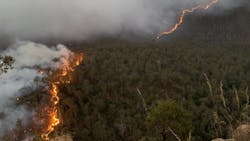Aussie FFs Injured amid Wildfire Emergency
SYDNEY, Australia (dpa) - Amid record-breaking temperatures and a freshly imposed state of emergency in New South Wales, three Australian firefighters were injured Thursday after their truck was overrun by a bushfire in the southwest of Sydney.
The incident took place at the Green Wattle Creek blaze, more than 90 kilometres south-west of Sydney, where more than 40 homes have been destroyed in the area. It came only hours after the New South Wales government declared a week-long state of emergency starting from Thursday.
Two male firefighters were airlifted to a hospital with serious injuries while their female colleague was taken hospital in an ambulance, NSW Rural Fire Service (RFS) Commissioner Shane Fitzsimmons told reporters.
They are all being treated for burns, while another two firefighters were treated by paramedics for smoke inhalation, Fitzsimmons said.
The firefighters were "overrun and enveloped by fire" while they were working in the area to protect homes from the blaze, he said.
He also said there were reports of homes, businesses including a poultry farm and "many structures and buildings" being impacted by the fire at Green Wattle Creek, one of two blazes at an emergency warning level, which closed the Hume Highway as well.
Another emergency warning was issued for the Gospers Mountain "megafire," which has been burning for weeks with a 60-kilometre-long fire front. It is about 75 kilometres north-west of Sydney and has already burned more than 411,000 hectares of land.
Australia on Wednesday broke the record for the hottest day in the country for the second day in a row, with the average temperature climbing by one whole degree.
The average maximum temperature across the country was 41.9 degrees Celsius on Wednesday, breaking the record of 40.9 degrees set a day earlier, according to the Bureau of Meteorology (BoM).
Before that, the average maximum temperature was 40.3 degrees, recorded in January 2013. The records are likely to tumble again until Saturday.
Australia has been experiencing a widespread exceptional heatwave this week which is expected to last until Saturday and comes as parts of the country face severe drought and a massive bushfire crisis, which started early this year in October.
Due to extreme heatwave conditions, the state government announced the second state of emergency of this bushfire season, which comes just ahead of Christmas.
"The decision to declare a state of emergency is not taken lightly," NSW Premier Gladys Berejiklian told reporters in Sydney on Thursday.
"It normally only goes for seven days and you have to make sure conditions are serious enough for that declaration to be made."
The emergency means state residents and visitors need to follow the advice of authorities over the next week and may even have to revise their Christmas plans, Berejiklian said.
A state of emergency gives the state Rural Fire Service and its commander extensive power to mobilize all state resources, coordinate evacuations, shut down gas, electricity, oil and water services, as well as stop, start, or make use of any facilities or premises.
New South Wales, the most populous state in Australia with Sydney as its capital, has been battling a major bushfire crisis with almost 3 million hectares of land already burned.
The last state of emergency was in mid-November due to "catastrophic" bushfire risk and lasted for a week.
More than 1,700 firefighters on Thursday are battling 100 bushfires in extreme fire conditions threatening large parts of the state.
The danger has exacerbated due to extreme heatwave across the state with the weather bureau forecasting above 40 degrees Celsius.
Authorities asked people to be vigilant about their health as the air quality in many parts of the state has been rated hazardous, very poor or poor.
The New South Wales health department said it has deployed some 180 extra paramedics on the ground on Thursday as to bushfire smoke continued to result in very poor air quality in Sydney.
Brad Hazzard, NSW health minister, said there had been 28 days of hazardous air quality between November 1 and December 18.
Meanwhile, the Bureau of Meteorology (BoM) has issued a climate outlook, saying the Christmas and New Year period "is likely to be drier than average" for much of Australia's north and east, and wetter in the west.
From January through March next year, daytime temperatures are likely to be above average across Australia, while nights are likely to be warmer than average for Australia, except parts of country's southeast, the bureau said in a statement on Thursday.
Defence Minister Linda Reynolds told Australian broadcaster ABC that the Australian Defence Forces (ADF) were helping out with the firefighting effort in one of the country's biggest peacetime movements of military personnel.
———
©2019 Deutsche Presse-Agentur GmbH (Hamburg, Germany)
Visit Deutsche Presse-Agentur GmbH (Hamburg, Germany) at www.dpa.de/English.82.0.html
Distributed by Tribune Content Agency, LLC.
